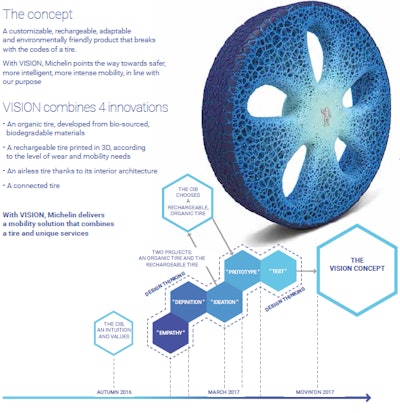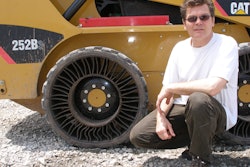Video produced by Engadget.com
Content below from Michelin's press release on the Vision concept tire
Michelin's Vision concept tire is airless, connected, rechargeable, customizable and organic. It is both a wheel and a tire.
Vision is a dream within reach because this revolutionary solution is driving the convergence of innovations already explored by Michelin's R&D teams.
The Michelin Corporate Innovation Board (CIB) issued a road map for the Vision tire at the outset of the project: imagine an object that symbolized the mobility of the future, that was packed with converging technologies and offered an ultra-high level of environmental performance.
Michelin began by listening to people, from city motorists to race drivers, from farmers to airline pilots, from engineering equipment drivers to children barely old enough to ride bikes. Some 90 people, divided into four panels around the world were questioned about their relationship with mobility. From these discussions, important needs were identified, in particular concerning sustainability. No users wanted to reduce their need for safety. Grip in all weather conditions and effective braking in all circumstances were essential. In addition, users embraced environmental responsibility. They wanted to consume cleanly. Why choose between a fully biodegradable tire and a rechargeable tire? Jean-Dominique Senard and the members of the Corporate Innovation Board said: “Give us both”.
An organic tire -- The materials used, which were both bio-sourced and biodegradable, minimized the tire’s environmental footprint.
A 3D-printed tire -- Vision is the world’s first tire that recharges. With the aid of 3D printers, it is possible to use just the right amount of rubber on the tire and thus extend its life depending on needs, thereby ensuring mobility in all situations. The tread design is optimized and its depth is reduced in order to reduce its thickness and make the tire more efficient in terms of materials. The tread design is adapted, in accordance with the user’s mobility needs, with a triple concern for comfort, safety and sustainability.
An airless tire -- Vision does away with air, relying instead on an interior architecture capable of supporting the vehicle, ensuring the solidity of the wheel and thus guaranteeing both comfort and safety. Vision can neither explode nor blowout.
A connected tire -- Equipped with sensors, Vision provides real time information about its condition. What’s more, thanks to Michelin’s mobile application, it’s possible to simply make an appointment to change the tire’s destination, depending on the user’s needs.



















